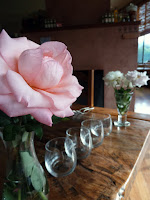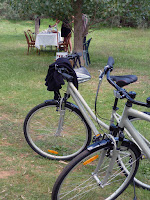Villa Gusto, at the foot of Mount Buffalo in Buckland.
Saturday, March 31, 2012
Friday, March 30, 2012
High Country hunt
TODAY was all about food, and I spent the day in the King Valley with a gaggle of locals who not only know where to find the best free-range ingredients but how to cook the goodies into wonderful home-style feasts.
Bright chef Patrizia Simone - the matriarch of the Simone family and the force behind Simone's Restaurant - was leading out little party of foodies and we spent the morning foraging for the ingredients she and her chef son Anthony would use to prepare lunch.
We met High Country local Franca Norris in Mrytleford and she took us to a spot beside the Great Alpine Road where we parked our cars and walked into the bush to fossick for the mushrooms that grow below the old pines when the weather turns cold.
The treasure was saffron milk caps, a plump little mushroom the color of orange sherbet, and we walked along a fire trail in the gloom below the dense canopy with our eyes scanning ground that was carpeted by fallen pine needles.
Frana's father is one of the King Valley's top mushroom hunters, and he has passed his skills on to his daughter, and she now spends many hours from autumn to spring walking through the bush collecting baskets of fresh fungi.
Our next stop was at a chestnut farm in Wandiligong, out past Bright, where we got a lesson on another of the High Country's top crops seeing the fruit on the tree and sampling a few dishes prepared once the nuts were harvested and roasted.
Then it was back into Bright for lunch at Simone's restaurant which included pasta with mushrooms and an meringue-like desert made from chestnuts.
Thursday, March 29, 2012
And then, afternoon tea
AFTER a day of grazing there was one more stop on the Rutherglen itinerary.
On the way back to town we took a detour to visit Ross and Kay Perry at their historic estate on a dusty hill near town.
The Perrys own Valentines Bakehouse - they have a few bakeries through the north of the state famous for a delicious sour dough bread - and they live in the historic Olive Hills homestead beside the road into town.
The antique homestead is magnificent with worn red bricks, ornate wrought-iron lace crowning the shady veranda, and weathered tin roof, and the grand dwelling seemed to glow in the golden afternoon light that fell across the baked red dirt surrounding the house.
Grape growing and wine making has also become a passion, and Ross is reviving the neglected vineyard that flanks the long driveway into the property when he's not baking bread at Valentines.
The family is slowly growing this satelite business, welcoming visitors on Saturday and Sunday afternoons to sit under the eucalyptus in the backyard and enjoy the wood-fired pizzas made by Ross while lingering over the property's menu of red and white wines.
The Olive Hills grapes are grown without the assistance of irrigation, with the original vines planted back in 1886, and I commented that I could taste the red dust in the robust durif that's considered to be one of the estate's signature drops.
I don't know if it was the proper thing to tell a proud winemaker, but I said it as a compliment because I could really taste the rustic location in the liquid, and that's something vineyard owners around the world strive for with every vintage.
Wednesday, March 28, 2012
The Sweet Cycle
I'M away again, this time doing three days in the north of Victoria covering a swathe of the landscape from Rutherglen up near the Murray to Bright at the foot of Mt Buffalo.
I am spending my first day in Rutherglen to see what the region is doing for the inaugural High Country Harvest, a food and wine festival happening at the end of May, and the locals are giving me a sneak peak at The Sweet Cycle.
It's an organised bike ride, set to be done on a lazy Sunday with participants decked out in the best vintage threads as they pedal around the village, and the event will include three grazing experiences at a selection of the region's loveliest locations.
We started with morning tea at Jones Winery on the outskirts of Rutherglen, and it was the chance to warm up with a 2km pedal from the centre of town to the cellar door where we found tables set with vintage cups and saucers and cake plates stacked high with sweet and savour yummies.
After a few more kilometres on the bikes we came to our second spot on the edge of town, where a table had been set under the birch trees beside the old Vidal Cellars for us to sample some of the region's famed fortified wines while enjoying charcuterie plates packed with more local produce.
One of the locals in my little touring group told me the Vidal Cellars were established in the 1800s as Rutherglen's first attempt at protecting the region's brand.
Back then there were dozens of vineyards and wineries producing a range of fortified wines, some good and some not so great, so the locals banded together to build the property as a place where all the grapes would be deposited after harvest and made into quality varieties that would build the town's reputation for the good.
It worked, with Rutherglen becoming one of the country's top spots for making sherry.
The Vidal Cellars fell into disrepair after a few decades of use and is now beautifully decrepit, with a family of sheep employed to keep the grass down, but word has it someone has bought the site and is keen to build a boutique hotel.
Not a bad place to stop for lunch, and our tasting plates were packed with local meats, pate, olives, a host of other savoury treats.
There was a marathon pedal to the next location - well, it was 7km - following the section of the Mountains to Murray Rail Trail that winds past the paddocks between Rutherglen and the hamlet of Wahgunyah where the All Saints Winery which is the last stop on The Sweet Cycle.
We were met by winery
staffer with a cold drink and then given a guided tour of the historic
vineyard and winery before settling in the cellar door to taste some of
All Saint's famed fortifieds, including a sherry and a muscat that have
both been aging in barrels for a handful of decades.
All Saints was established in 1864, making it one of the country's oldest wineries, and today the estate's buildings are surrounded by vines planted 85 years ago in the sandy-loam soils just south of the Murray.
Tuesday, March 20, 2012
Trip #5 (2012)
THE stats from my three-day expedition to Victoria's Yarra Valley...
Flights - None, which isn't a bad thing
Kilometres flown -None, like I say, not a bad thing
Total kilometres flown in 2012 - 46,942km
Hotels - Serenity House (Healesville), Saladin Lodge (Narbethong)
Total hotels in 2012 - 15
Countries visited - Home
Total countries visited in 2012 - Still only three
New countries visited - Still holding on 49
Next I have two more local trips lined up, Rutherglen next week and then a quick dash to Gippsland.
Monday, March 19, 2012
Black Saturday ghosts
I MADE a quick dash to the top of Lake Mountain this afternoon to have a close look at the alpine resort's new day lodge and talk to a staffer about activities on offer during the "Green Season" and once the white stuff starts falling in a few months.
Lake Mountain was another popular recreation spot damaged on Black Saturday, and I was told about a cook who hid from the fire as it swept across the summit after racing up the side of the peak.
The snow gums and mountain ash trees that carpet the side of Lake Mountain were destroyed that day, and today the bare branches stood naked against an overcast sky like lonely ghosts.
Sunday, March 18, 2012
Surviving a Black Saturday
THIS part
of Victoria was badly beaten on February 7, 2009, when fierce bushfires burnt
across our state destroying hundreds of properties and claiming the lives of 173
people who strayed into its destructive path.
Healesville,
the peaceful settlement positioned at the heart of the Yarra Valley, was
literally surrounded by flames on Black Saturday and threatened for days as a
troop of fire fighters battled to bring the fickle blaze under control.
Just
across the Black Spur, the infamous line of mountains that challenge even the
most confident driver with a road that twists and turns beneath a canopy of
towering gums, Marysville was all-but destroyed when another fire blew out of the
bush beside town.
I left
Healesville after breakfast and headed across the Black Spur to visit this region belted on
Black Saturday, and to find a couple of stories that could run Escape to encourage visitors back to a
part of Victoria that depended so heavily on tourism before the 2009 fires.
I'm
staying at a B&B tonight, a rural estate called Saladin Lodge, a idyllic property that welcomes visitors with a blend of country hospitality and urbane style.
This
place sits at the very spot where the Murrindindi Fire burst out of the forest on
the afternoon of February 7 and split to follow the highway north and south to burn
across the top of Buxton in one direction and Narbethong in the other.
Kim
Rycroft owns Saladin Lodge, and she was one of the many Narbethong residents
that lost property that day.
She was
in Melbourne on Black Saturday, but the friends looking after her country block
fled when the fire crossed the road and then raced the flames to Yea in search
of safety.
Kim's cottage
was destroyed, as were the stables and historic outer buildings on her
Narbethong property, but the fire jumped across the half-built shell that now
houses Saladin Lodge.
It took
her a couple of years to get back on her feet, to clean up her block and finish
the B&B, but now Kim welcomes guests who stay in the comfortable suites
that look across the recovering bush.
The undulating hills that surround Saladin Lodge are scarred, with a jumble of black trunks and branches still showing just how ferocious the Black Saturday fires were, but a carpet of green is slowly settling on the burnt land as new leave take hold.
The burnt trees are dead, and will fall in their own good time to be replaced by the saplings now growing in their shadows, and when I was walking around the Saladin swimming hole one of the trunks fell on the neighbouring hill, falling with a loud crack.
Kim told me her story at dinner tonight, taking more than an hour to share the details of that dreadful, and it was fascinating to hear a version of the story from one of the people who survived the historic event.
We’ve all heard the stories from that day time and time again on the news,
but those versions were sanitised and lacking the emotion that comes with a
face-to-face telling.
Sitting on the spot where it all happened, looking across the recovering landscape, and hearing
from a person so acutely affected by Black Saturday was both fascinating and
horrifying.
Subscribe to:
Comments (Atom)































































